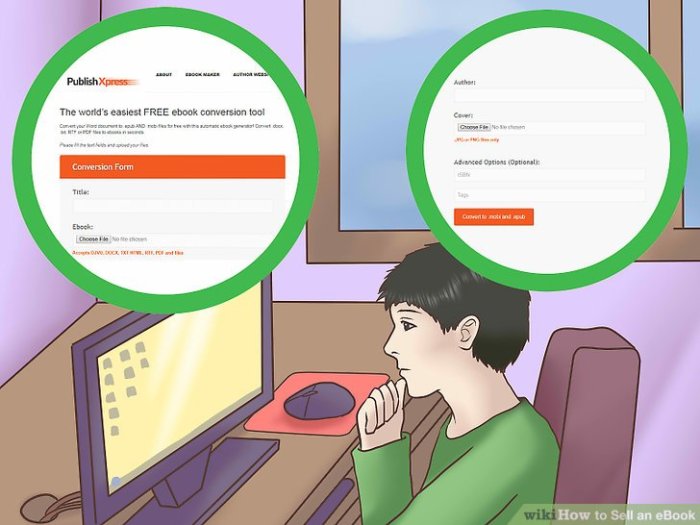
Delving into How to write and sell an eBook, this guide opens up a treasure trove of insights for aspiring authors and entrepreneurs alike. Whether you’re a seasoned writer or just starting, this comprehensive approach will empower you to craft a captivating eBook that resonates with readers and stands out in a crowded market.
From structuring engaging chapters to implementing innovative marketing strategies, this overview covers essential steps to ensure your eBook not only attracts attention but also converts readers into loyal customers. Prepare to explore the nuances of writing, promoting, and distributing your eBook effectively.
Utilizing Online Platforms for eBook Distribution

In the digital age, the distribution of eBooks has become more accessible than ever, thanks to various online platforms. These platforms not only allow authors to publish their work but also provide tools to reach a broader audience. Understanding the unique features of each platform is essential for maximizing sales and visibility.
Popular Platforms for Selling eBooks
Choosing the right platform can impact your eBook’s success. Here are some of the most popular platforms available, along with their unique features:
- Amazon Kindle Direct Publishing (KDP): Amazon KDP is arguably the most popular platform for eBook distribution. It offers a vast audience and allows authors to set their own prices, offering up to 70% royalties on sales. Notably, authors can enroll their books in Kindle Unlimited for additional exposure.
- Kobo Writing Life: Kobo provides a user-friendly experience for authors and readers alike. It supports multiple file formats and offers promotional tools like Kobo Promotions, allowing for targeted marketing to enhance visibility.
- Apple Books: This platform caters to users within the Apple ecosystem. It boasts a clean interface and high-quality reading experience, alongside robust promotional opportunities that leverage Apple’s marketing capabilities.
- Smashwords: Known for its wide distribution network, Smashwords allows authors to distribute their eBooks across multiple retailers and libraries. The platform provides valuable marketing resources and tips to help authors navigate the eBook market.
- Google Play Books: Google Play Books enables authors to reach Android users globally. It offers flexible pricing and promotional options, alongside analytics to track performance and audience engagement.
Using Blogging to Drive Traffic to eBook Sales
Blogging serves as an invaluable tool for driving traffic to your eBook sales. By sharing valuable content related to your eBook’s subject matter, you can attract potential readers and create a loyal audience. Here’s how effective blogging can boost your eBook sales:Creating engaging and informative blog posts that resonate with your target audience helps establish your authority in the genre.
This can lead to readers trusting your expertise and being more willing to purchase your eBook. Additionally, incorporating relevant s improves your blog’s visibility on search engines, making it easier for potential readers to discover your content. Including links to your eBook within the blog and using calls-to-action encourages direct purchases.
“Regularly updating your blog can significantly enhance your eBook’s visibility and sales potential.”
Designing Promotional Banner Advertisements for eBook Marketing Campaigns
Promotional banners are essential for visually capturing potential buyers’ attention and conveying vital information about your eBook. When designing a promotional banner, consider the following elements:
1. Compelling Imagery
Use striking visuals related to your eBook’s theme. An appealing cover image, combined with relevant background graphics, can draw interest.
2. Clear Messaging
The text should be concise yet informative. Highlight the eBook’s title, a brief tagline, and essential selling points such as promotions or reader reviews.
3. Call to Action
Incorporate a strong call to action such as “Buy Now” or “Download Today” to encourage immediate engagement.
4. Brand Consistency
Ensure that the banner aligns with your author brand. Consistent colors, fonts, and overall design maintain a professional appearance and enhance brand recognition.
5. Responsive Design
Create banners that adapt to various screen sizes, ensuring they look great on both desktop and mobile devices.By effectively utilizing online platforms, engaging in strategic blogging, and crafting eye-catching promotional materials, authors can significantly enhance their eBook distribution efforts and reach wider audiences.
Concluding Remarks

In conclusion, mastering the art of writing and selling an eBook involves a blend of creativity, strategic marketing, and savvy distribution. By following the Artikeld steps from conception to promotion, you can turn your ideas into a profitable eBook that reaches audiences far and wide.
FAQ Guide
What are the best platforms to sell my eBook?
Popular platforms include Amazon Kindle, Apple Books, and Google Play Books, each offering unique features for reaching different audiences.
How do I price my eBook?
Consider factors like length, genre, and market demand; researching competitor prices can also help you set a competitive price.
Can I update my eBook after publishing?
Yes, most platforms allow you to update your eBook content, which can be useful for correcting errors or adding new information.
Do I need an ISBN for my eBook?
While not always necessary, having an ISBN can help with distribution and makes your eBook more professional.
How can I encourage reviews for my eBook?
Encourage readers to leave reviews by connecting with them through emails or social media, and by offering incentives like free bonus content.





